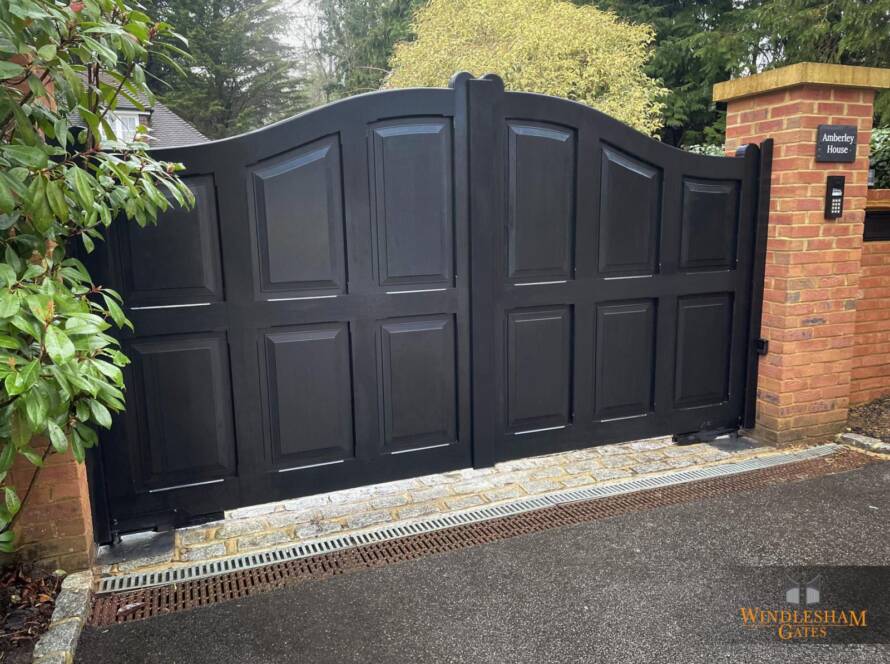Electric gates have become an increasingly popular choice for enhancing security and convenience in residential and commercial properties. These gates rely on a complex system of mechanics, electronics, and electrical components to automate their operation. In this article, we will explore in detail how electric gates work, from their primary components to the intricate processes that enable seamless functionality.
Components of an Electric Gate
The gate panels are the physical barrier that moves to open or close the entrance. They can be swing gates, sliding gates, or even vertical lifting gates, depending on the design.
Motors
Electric gate motors are the powerhouses that provide the necessary force to operate the gate. They can be hydraulic or electromechanical, each with its own advantages and considerations.
Control Panel
The control panel serves as the brain of the electric gate system. It receives signals from various sensors and remote control devices, determining the gate’s response and ensuring smooth operation.
Sensors
Safety sensors are crucial elements that detect obstructions or motion, preventing accidents by triggering immediate reversal or halting of gate movement.
Access Control Systems
These systems, such as keypads, remote controls, or intercoms, are responsible for allowing authorized users to operate the gate. They can be linked to various security features like cameras and proximity cards.
Understanding the Electrical System
Power Supply
Electric gates require a reliable power source, usually from the main electrical grid or specialized gate power supplies. Backup battery systems can provide electricity during power outages.
Control Wiring
Low-voltage control wires connect the control panel to various components of the gate system. These wires transmit signals to initiate gate movement or activate safety features.
Safety Mechanisms
Various safety mechanisms ensure the well-being of users and prevent accidents. These include safety edges, photocells, and magnetic locks that work in cohesion with the control panel to monitor gate operation and detect any potential risks.
Motor Operation
Electric gate motors receive commands from the control panel to initiate gate movement. Depending on the type of motor, hydraulic fluid or electric power is used to generate the necessary force.
Limit Switches
Limit switches are installed to define the gate’s open and closed positions accurately. Once the gate reaches these positions, the limit switch sends a signal to the control panel, stopping motor operation.
Control Panel Programming
The control panel can be programmed to perform specific functions, such as setting gate opening and closing times, adjusting motor force, or integrating with other security systems.
The Gate Opening Process
Signal Reception
When a user triggers the gate opening process, either through a remote control or an access control system, the control panel receives the signal.
Safety Check
Before the gate begins to move, safety sensors and limit switches are activated to ensure there are no obstacles or potential risks in the gate’s
Motor Activation
Upon receiving the signal and passing the safety check, the control panel activates the gate motor. The motor then starts to generate force, causing the gate panels to move accordingly.
Monitoring and Feedback
Throughout the opening process, the control panel continuously monitors the gate’s position and receives feedback from sensors and limit switches. This data helps ensure smooth operation and detect any faults or obstructions that require immediate attention.
Gate Integrity
Several safety features, such as force adjustments, anti-crushing mechanisms, and torque limiters, are in place to prevent damage to the gate or injury to users. The control panel oversees these safety measures during the entire operation.
IV. Reducing Common Issues and Troubleshooting (500 words)
Maintenance and Lubrication
Regular maintenance and lubrication of moving parts, hinges, and motors are essential to prevent wear and extend the gate’s lifespan.
Sensory System Checks
Periodically inspect and clean sensors, photocells, and safety edges to ensure their efficiency and proper operation.
Remote Control or Access System Issues
If the gate fails to operate using remote controls or access control systems, troubleshooting techniques such as battery replacement, signal interference checks, or reprogramming may be required.
Motor Malfunctioning
In case of motor-related issues, professional assistance should be sought. Common troubleshooting steps include checking for loose connections, fuse replacements, or motor realignment.
Electric gates work through a combination of mechanical, electrical, and electronic components that enable smooth and automated gate operation. Understanding the various elements involved, from gate panels to control panels and safety sensors, is vital in comprehending the intricate processes behind the functioning of electric gates. By maintaining regular checks, adhering to safety protocols, and troubleshooting common issues, users can ensure the longevity and reliable performance of their electric gates. Let us embrace this technological advancement in securing our properties while equipping ourselves with the knowledge to appreciate and maintain these modern gate systems.



